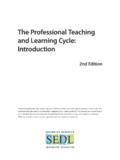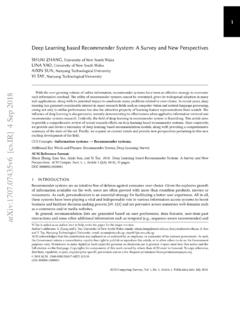Transcription of An Introduction to Work-Based Learning
1 An Introduction to Work-Based Learning UK Physical Sciences Centre Department of Chemistry University of Hull Hull HU6 7RX Phone: 01482 465418/465453 Fax: 01482 465418 Email: Web: Tom Lemanski, Ruth Mewis and Tina Overton February 2011 ISBN 978-1-903815-27-4 A Physical Sciences Practice Guide Introduction to Work-Based Learning An Introduction to Work-Based Learning Tom Lemanski, Ruth Mewis and Tina Overton February 2011 Published by the Higher Education Academy UK Physical Sciences Centre The views expressed in this practice guide are those of the authors and do not necessarily reflect those of the UK Physical Sciences Centre. The practice guide is an expansion of the published article entitled An Introduction into the recent literature on approaches to Work-Based Learning , by the same authors.
2 Introduction to Work-Based Learning Introduction to Work-Based Learning 1 Table of Contents Abstract .. 2 Aims of this guide .. 2 Identifying the need .. 3 Defining Work-Based Learning .. 5 Learning for work .. 5 Learning at work .. 6 Learning through work .. 6 Work-Based Learning approaches .. 6 Different models of Work-Based Learning .. 9 Work-Based Learning curricula in the UK .. 11 University of Derby .. 11 Northumbria University .. 11 Scottish Centre for Work-Based Learning , Glasgow Caledonian University .. 13 University of Hull .. 14 University of Portsmouth .. 15 Middlesex University .. 17 University of Central Lancashire .. 19 Key points from module outlines .. 20 Implementation of Work-Based Learning .
3 20 Accreditation of prior and experiential 21 Perceived challenges of Work-Based Learning .. 22 Summary .. 23 Methods for assessing Work-Based Learning .. 24 Self and peer assessment .. 24 Assignments and projects .. 24 Memorandum report .. 24 Portfolios .. 25 Dissertations and theses .. 25 Presentations .. 26 Poster displays .. 26 Learning contracts .. 26 Summary .. 27 Conclusions .. 28 Summary of the benefits of Work-Based Learning .. 28 References .. 29 Introduction to Work-Based Learning 2 Abstract The term Work-Based Learning is widely used throughout the literature, academia and industry to describe a multiplicity of approaches by which one can learn through work . The complex nature of Work-Based Learning can often lead to confusion when designing courses which aim to implement such an approach.
4 This practice guide will focus on: 1. The rationale for conducting Work-Based Learning . 2. The varieties of approaches to Work-Based Learning that are currently implemented. 3. Student opinions of Work-Based Learning . 4. How to resolve any implementation and communication issues. There are many approaches to developing Work-Based Learning modules, courses and projects that utilise Learning at, Learning for, and Learning through work . Aims of this guide This practice guide is to give an overview of some of the current literature exploring Work-Based Learning , as well as outlining case studies of Work-Based Learning modules currently implemented at several Higher Education Institutions (HEIs) throughout the United Kingdom.
5 This should provide the reader with a general idea of how Work-Based Learning is approached and how module outlines can be created and adapted to appeal to HEIs, employers and learners. This guide contains three key sections: 1. Literature review. 2. Work-Based Learning modules. 3. Assessment guide. This guide should be useful during the development of Work-Based Learning modules as part of a Higher Education qualification. Once you ve explored this booklet you should: 1. Understand that Work-Based Learning is a flexible tool. 2. Understand the variety of Work-Based Learning approaches. 3. Be able to design a module that appeals to the tripartite of HEI, employer and learner. 4. Appreciate any issues that may arise for HEI, employer or learner with respect to Work-Based Learning .
6 5. Be able to utilise a number of the assessment tools explored to provide the best feedback and evaluation for learners. Introduction to Work-Based Learning 3 GCSEs grade A*-C BTEC First Diplomas and Certificates Key skills and NVQs at level 1 Level 2 A-levels and GCE in applied subjects International Baccalaureate Key skills and NVQs at level 3 BTEC Diplomas, Certificates and AwardsLevel 3 NVQs at Level 4 BTEC professional Diplomas, Certificates and Awards Certificate of Higher EducationLevel 4 Diploma of Higher Education Foundation DegreesLevel 5 Identifying the need Many reports identify the need to up-skill the workforce,1, 2 with the Leitch Review of Skills setting short and long term goals for education in the UK.
7 The Cogent Skills Review analyses in great depth the many aspects affecting the major science, technology, engineering and mathematics (STEM) industries. It outlines future priorities for each industry whilst considering the role of Sector Skills Councils (SSCs) in increasing the skills of the workforce within the chemicals, pharmaceuticals, oil and gas, nuclear, polymer and petroleum The Leitch Review of Skills sets an ambitious target; that by 2020 the UK will be within the top eight worldwide for each skill level, with emphasis on delivering qualifications to a far higher percentage of the workforce. The targets aim for over 90% of adults qualified to above Level 2 whilst also shifting the balance of skills from Level 2 to Level 3 as well as increasing those with Level 4 qualifications and skills from 29% to 40%, combined with increasing the number of adult The skill levels are defined by the National Qualifications Framework (NQF) as shown in figure 1:3 Figure 1: Skills levels, as defined by the National Qualifications The level of upskilling described in the Leitch Review means that a greater partnership involving educational institutions and employers is required.
8 Levels 4 and above are of interest for HEIs where collaboration with industry is traditionally not common. The main recommendations for the improvement of skills in the UK are identified in the Leitch Review; the following recommendations are reproduced directly from the Review of Skills:2 Increase adult skills across all levels. Route all public funding for adult vocational skills in England, apart from community Learning , through Train to Gain and Learner Accounts by 2010. Strengthen employer voice. Introduction to Work-Based Learning 4 Increase employer engagement and investment in skills. Launch a new Pledge for employers to voluntarily commit to train all eligible employers up to Level 2 in the workplace.
9 Increase employer investment in Level 3 and 4 qualifications in the workplace. Increase people s aspirations and awareness of the value of skills to them and their families. Create a new integrated employment and skills service. The Leitch Review anticipates that Sector Skills Councils will take an integral role in the approval of vocational qualifications; this allows for cooperation between employers with SSCs to produce qualifications that benefit industries; these courses may be delivered at established institutions as well as Work-Based Learning qualifications and in turn will attract public The 2009 report entitled Skills for Growth highlights and reiterates the importance of increasing the standard and number of technicians within industry,4 increasing the number of formalised qualifications obtainable particularly through apprenticeships.
10 Introduction to Work-Based Learning 5 Defining Work-Based Learning It is widely being acknowledged that Work-Based Learning (WBL) strategies are a vital part in the ongoing and future development of the existing workforce. For example, in Europe the Developing European work based Learning Approaches and Methods (DEWBLAM) project5 intended to develop a Europe-wide network of models and approaches to WBL within a European consortium of establishments, with the aim of allowing access to Higher Education qualifications for those adults currently in employment, through accreditation of prior and experiential Learning . A broad definition of WBL is offered in Work-Based Learning : A New Higher Education6 where the authors expand upon their definition to include meeting the requirements of learners and the contribution that this Learning will have in the development of the organisation in the long term:6 Work-Based Learning is the term being used to describe a class of university programmes that bring together universities and work organizations to create new Learning opportunities in workplaces.













